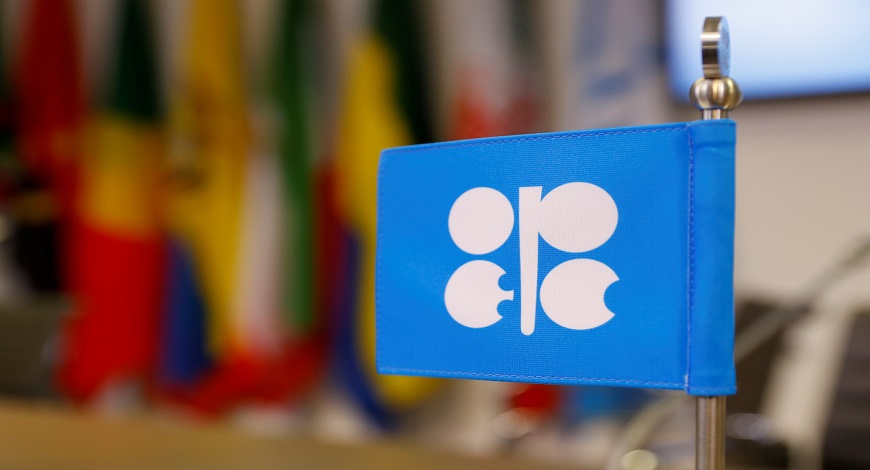(Bloomberg) –After five days of difficult talks that exposed new rifts between core members, OPEC+ agreed to gently ease output cuts next year. The deal appeared to satisfy the oil market and most of the cartel’s members but strained the group’s unity and set up testing times ahead.
Saudi Energy Minister Prince Abdulaziz bin Salman, de facto leader of the group alongside his Russian counterpart, was frank that the deal was hard-won.
“It’s very excruciating, it’s very tiring,” Prince Abdulaziz told reporters after the meeting on Thursday. “If you want to work with 23 countries, you have to be very congenial to the idea of flexibility.”
For all his talk of fatigue, the prince had just signed up to an even more grueling schedule of meetings between the Organization of Petroleum Exporting Countries and its allies, which will define the trajectory of crude prices for months to come.
After a split emerged between Saudi Arabia and the United Arab Emirates, the cartel couldn’t agree on what had been widely expected before this week: a full three-month delay to the scheduled January output increase. Instead ministers resolved to add 500,000 barrels a day of production to the market next month, then hold monthly meetings to decide on subsequent moves.
The accord could add a maximum of 2 million barrels a day to the market, but ministers could equally decide to cut production again if needed, said Russia’s Deputy Prime Minister Alexander Novak. The maximum change in any month will be 500,000 barrels a day in either direction.
After this week’s drawn-out negotiations, it’s not “the nightmare scenario that the market feared, but it is not what it really expected weeks ago,” said Rystad Energy AS senior analyst Paola Rodriguez-Masiu. “The fact that February’s production levels are still under discussion puts more uncertainty ahead for the coming OPEC+ meetings.”
Responding to Uncertainty
The revised deal is not as conclusive as many OPEC-watchers had expected, but it could be a rational response to the tremendous uncertainty in energy markets.
OPEC+ is only just emerging from a period of historic turbulence. It rescued the oil market earlier this year from an unprecedented slump, slashing production by 9.7 million barrels a day as the pandemic crushed demand.
The cartel returned 2 million barrels a day of that output to the market in August without a hiccup and was due to add a similar volume next month. Yet several members of the group were worried that the market was still too fragile to absorb those extra barrels.
While a breakthrough in vaccines to tackle the coronavirus spurred a rally in oil prices, a resurgence in infections has triggered a new wave of lockdowns and inflicted a fresh blow to fuel consumption. The cartel and the wider industry have downgraded their outlooks for 2021, with a picture that’s sharply polarized between recovery in Asia and stagnation in Europe.
How Much?
The January output increase, which is just a quarter of what would have occurred under the previous OPEC+ deal, is likely to keep the oil market in deficit throughout the first quarter, according to Bloomberg calculations using OPEC data. That means bloated fuel inventories that weigh on prices will continue to drain.
“This 0.5 million barrels a day absolutely will be absorbed in the market very easily,” Amrita Sen, co-founder of consultant Energy Aspects Ltd., said in an interview with Bloomberg TV on Friday. “This really does make sure that the market will not be in oversupply in the first quarter.”
Brent crude jumped 2.1% to $49.72 as of 8:07 a.m. in London, a nine-month high.
If the group had gone ahead with the full supply hike, the cartel’s economists had calculated that the market would have flipped into surplus, potentially undermining the recent price rally.
“It’s a wise decision,” Iran’s Oil Minister Bijan Namdar Zanganeh told state run news service Shana after the talks concluded. “These monthly meetings can help preserve stability in the market” and the additional supplies coming in January won’t have a big impact, he said.
Difficult Process
The flexibility afforded by a monthly cycle of high-stakes ministerial meetings may be desirable, but the process of getting there appears to be less so.
“There was a lot of drama in this meeting, and tensions flying high,” said Sen.
The intensity of a fight earlier this week between Saudi Arabia and the United Arab Emirates took OPEC-watchers by surprise. The pair have long been staunch allies, but Abu Dhabi is pursuing a more independent oil policy. It’s investing heavily in new production capacity, wants to pump more oil and believes its current quota is unfair. It even signaled last month it was considering its options outside the club.
On Monday, differences between the two countries prevented the cartel from reaching a clear agreement, forcing them to delay the scheduled meeting with OPEC+ allies by two days.
In an apparent gesture of frustration, the Saudi energy minister told the group that he may resign as co-chair. His UAE counterpart Suhail Al Mazrouei was offered the post, but refused, according to a person familiar with the situation. In the end, OPEC+ asked Prince Abdulaziz to stay put.
In his closing remarks after Thursday’s meeting, the prince chose to highlight the episode. “It’s sometimes very frustrating, and that’s why two to three days ago I threw in the towel,” he said. “But the towel comes back to me.”
Several analysts predicted more trouble ahead in 2021.
“Saudi-UAE relations continue to bear watching,” said Ed Morse, global head of commodities research at Citigroup Inc. “The UAE is likely to be more independent and influential in group affairs going forward.”



